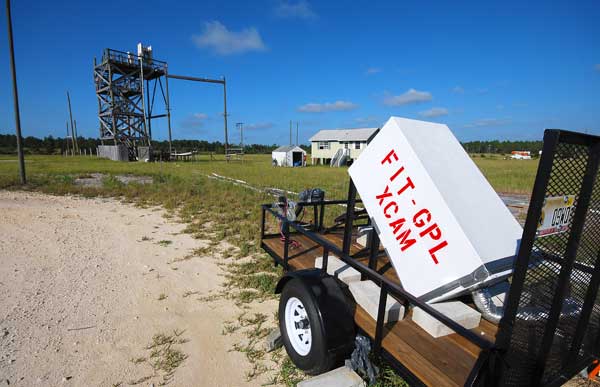X-ray Vision Sheds New Light on Lightning Strikes

SAN FRANCISCO – If Superman and Lois Lane watched lightning strike the tallest buildings of Metropolis, the superhero might puzzle his lady friend by describing a glow as seen through his X-ray vision. Now scientists have spotted the same by building a camera that captured the world's first X-ray images of lightning.
The fridge-sized camera snapped 10 million frames per second in order to capture lightning processes that last just millionths of a second. Florida researchers pointed the camera at a launch tower where they sent rockets soaring with trailing copper wire – a modern-day Ben Franklin experiment to trigger lightning.
"It's been 250 years since Franklin's kite experiment, and only within the last decade [eight years ago] we found that lightning emits X-rays," said Joseph Dwyer, a physicist at the Florida Institute of Technology in Melbourne, Fla.
The announcement and a first viewing of the images came at a press conference held today (Dec. 14) here at the fall 2010 meeting of the American Geophysical Union.
Here comes the glow
The X-ray glow follows a so-called lightning leader – a channel in the air that forms a path for the lightning. The leader's charged tip creates an electric field that accelerates electrons almost to the speed of light and causes the X-ray emissions. [Electrifying Images of Volcano Lightning]
That means the lightning itself is not the direct cause of X-ray emissions.
Get the world’s most fascinating discoveries delivered straight to your inbox.
"Lightning is too cold to emit X-rays," Dwyer explained. "Fifty-thousand degrees Fahrenheit may seem hot to us, but in terms of X-ray temperatures it is downright frigid."
The lightning leader that triggered the X-ray imagery was traveling at about one-sixth the speed of light – faster than the leader speeds of one-tenth or one-twentieth the speed of light seen in natural lightning strikes. [X-ray lightning image]
More than rocket science
Success aside, putting together the X-ray camera first required some heavy lifting. The camera has just a 3-inch (7.5-centimeter) pinhole that allows X-rays through the front, with heavy lead sheets shielding all other parts of the camera to prevent X-ray entry.
"Each sheet, which was approximately 2 by 1 foot, weighed 60 pounds," said Meagan Schaal, a graduate student in the physics and space sciences department at the Florida Institute of Technology. "Getting them into place and drilled into place was extremely difficult." (That's about 0.6 by 0.3 meters and 27 kilograms.)
The efforts paid off this past summer when the camera recorded four rocket-triggered lightning flashes. Other cameras at the launch site even captured a surrounding glow of gamma rays that also followed the lightning strikes.
A greenish cloud also appears to trail along the rocket-triggered lightning strikes in visual images, but that's not from gamma rays. Instead it marks the destruction of the copper wire that the rocket unspools in its wake.
"The green is from the copper vaporizing," Schaal said.
Anyone who recalls their high-school chemistry classes may have seen a similar greenish reaction when they put copper over a Bunsen burner, Schaal told LiveScience after the press conference.
Step by step
Another camera at the launch site captured a natural lightning strike from a storm that moved through the area. That lucky coincidence created the fastest frame-rate measurements ever taken of a lightning leader from a natural lightning strike.
"The camera was conditioned for rocket-triggered charges, but was fortuitously triggered by natural lightning," said Dustin Hill, a lightning researcher at the University of Florida in Gainesville.
The camera's 300,000 frames per second showed how the lightning leader creates a step-wise channel downward through the air. The lightning leader is also known as a step leader, because it seems to travel by leaps and bounds rather than in a continuous line.
The trail left by the step leader allows negative charge to travel down, even as positively charged leaders travel upward from the ground to meet in the middle. That triggers a so-called return stroke moving upward from the ground toward the cloud – the flash of what human eyes see as lightning.
Such images confirmed that laboratory spark experiments and rocket-triggered lightning seem to match well with natural lightning, at least in terms of the step-leader process. That suggests researchers may be on the right track when it comes to understanding the mysteries of lightning.
"The strokes after the step leader seem to be exactly [the] same as natural lightning," Hill said. "The advantage of triggered lightning is that it's like a laboratory experiment – we now have a repeatable experiment that we can do."
- Image Gallery: Lightning Strikes
- Image Gallery: Electric Earth
- Is It Possible to Have Lightning Without Thunder?
You can follow LiveScience Senior Writer Jeremy Hsu on Twitter @ScienceHsu.

